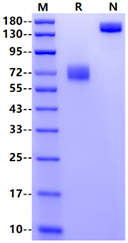Met20-Ser220, with C-terminal Human IgG1 Fc MIPPPEKVRMNSVNFKNILQWEVPAFPKTNLTFTAQYESYRSFQDHCKRTASTQCDFSHLSKYGDYTVRVRAELADEHSEWVNVTFCPVEDTIIGPPEMQIESLAESLHLRFSAPQIENEPETWTLKNIYDSWAYRVQYWKNGTNEKFQVVSPYDSEVLRNLEPWTTYCIQVQGFLLDQNRTGEWSEPICERTGNDEITPSIEGRMDPKSSDKTHTCPPCPAPELLGGPSVFLFPPKPKDTLMISRTPEVTCVVVDVSHEDPEVKFNWYVDGVEVHNAKTKPREEQYNSTYRVVSVLTVLHQDWLNGKEYKCKVSNKALPAPIEKTISKAKGQPREPQVYTLPPSRDELTKNQVSLTCLVKGFYPSDIAVEWESNGQPENNYKTTPPVLDSDGSFFLYSKLTVDKSRWQQGNVFSCSVMHEALHNHYTQKSLSLSPGK
1. Lutfalla, G. et al. (1993) Genomics 16:366. 2. Xie, M.-H. et al. (2000) J. Biol. Chem. 275:31335. 3. Kotenko, S.V. et al. (2003) Nat. Immunol. 4:69. 4. Yoon, S.I. et al. (2006) J. Biol. Chem. 281:35088.
Interleukin 10 receptor, beta subunit (IL10RB/IL-10RB) also known as Cytokine receptor family 2 member 4, Interleukin-10 receptor subunit 2, and cytokine receptor family II, member 4, is a subunit for the interleukin-10 receptor. Mature human IL-10 R beta consists of a 201 amino acid (aa) extracellular region with two fibronectin type-III domains, a 22 aa transmembrane segment and a 83 aa cytoplasmic domain. IL‑10 R beta is widely expressed, while the associated receptor subunits exhibit differential expression patterns. The ligand‑specific subunits are responsible for the divergent functions of these cytokines, encompassing immune suppression, promotion or inhibition of inflammation, mucosal defense, antiviral immunity, and hematopoiesis.

1μg (R: reducing conditions, N: non-reducing conditions).